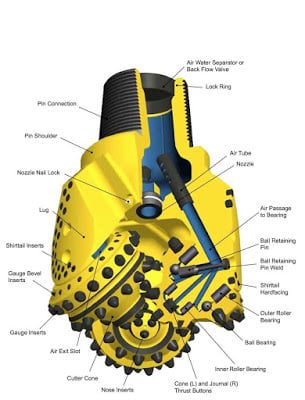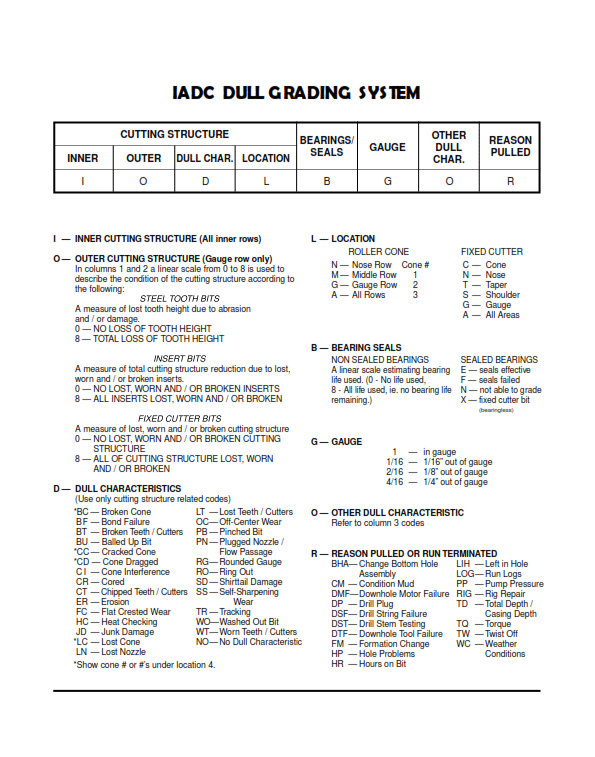The Oilfield Drilling Bits Article aims to introduce the reader to the selection and operation of drilling bits. Included in the article are discussions of
- Various bit types are available.
- Criteria for selecting the best bit for a given situation.
- Standard methods of evaluating dull bits,
- Factors affecting drilling speed
- Optimization of bit weight and rotary speed.
The process of drilling a hole in the ground requires the use of oilfield drilling bits. Indeed, the bit is the most basic tool the drilling engineer uses. Also, selecting the best bit and bit operating conditions is one of the most basic problems he faces. An extremely large variety of bits are manufactured for different situations encountered during rotary drilling operations. It is important for the drilling engineer to learn the fundamentals of bit design so he can fully understand the differences among the various bits available,3
The decision of selecting an oilfield drilling bit for a well is important as it has an impact on the total well cost (check also drilling cost per foot). Many factors should be considered:
- bit cost
- expected parameters (Le., turbines, rotary drilling, air operations)
- formation types and properties
- mud systems
- rig cost
The emerging technology for bit design adds additional significance when evaluating these parameters. Drilling optimization can be viewed in three distinct phases:
- Selecting the proper bit for the drilling conditions.
- Monitoring the drilling conditions on the prospect well so drilling performance is equal to or above the average in the particular area.
- Implementing a bit weight-rotary speed program from theoretical calculations will improve drilling performance above the best wells in the area.
Types of Oilfield Drilling Bits Used on Rig
Rotary drilling bits are usually classified as drag bits or rolling cutter bits according to their design. All drag bits consist of fixed cutter blades that are integral to the body of the bit and rotate as a unit with the drill string. This type of drilling bits dates back to the introduction of the rotary drilling process in the 19th century. Rolling cutter bits have two or more cones containing the cutting elements, which rotate about the cone’s axis as the bit is rotated at the bottom of the hole. A two-cone rolling cutter bit was introduced in 1909.
For more information, please check our guide to types of drilling bits in oilfield rigs.
Roller Cone Drilling Bits

The Roller cone drill bit is widely used in drilling oilfields. But to start to choose what you need, you must understand the following topics:
- Roller Cone Bit Design:
- IADC Roller Cone Drill Bit Classification
- TRI Cone Running Procedures
- Roller cone Bit Performance
Fixed Cutter Bits

Fixed cutter drilling bits have proven themselves in the oilfield as they had a long life but under certain conditions. We have provided you with the following topics to completely understand what Fixed Cutter Bits.
- PDC Bits :
- IADC PDC Bit Classification
- PDC Running Procedures
- PDC Bit Drilling & Operating Parameters
- PDC Bit Performance
BIT DULL GRADING

Dull bit grading is a standard method to grade the bit, and it will also help personnel to understand bit performance better. However, it is sometimes very difficult to understand the meaning of the codes shown in the grading because you’ve never seen these dull characteristics before. Especially some new people start to work in the oilfield; therefore, it is very critical to have them learn the correct way to do the bit grading quickly.
In the IADC Bit Dull Grading article, we explained how to perform dull grading, and you can also download the IADC Bit Dull Grading Handbook. Check also:
Drill Off Test
The drill-off test for any oilfield drilling bits determines the optimum weight on bit and overall bit performance. A given amount of weight is put on the bit, and the draw works brake is tied off so that no more weight is applied to the bit as it drills. The time it takes for the bit to stop drilling ahead with the given weight is measured. Different weights are applied, and the times are compared to determine the best amount.
The drill of test procedures article will discuss the passive and active types and how you could perform both.
Factors Affecting Oilfield Drilling Bit Penetration Rates
The penetration rate that can be achieved by a bit has an inverse effect on the drilling cost per foot. The main factors that affect the penetration rate are
- bit type
- formation properties
- drilling fluid properties
- bit weight and rotary speed
- bit hydraulics